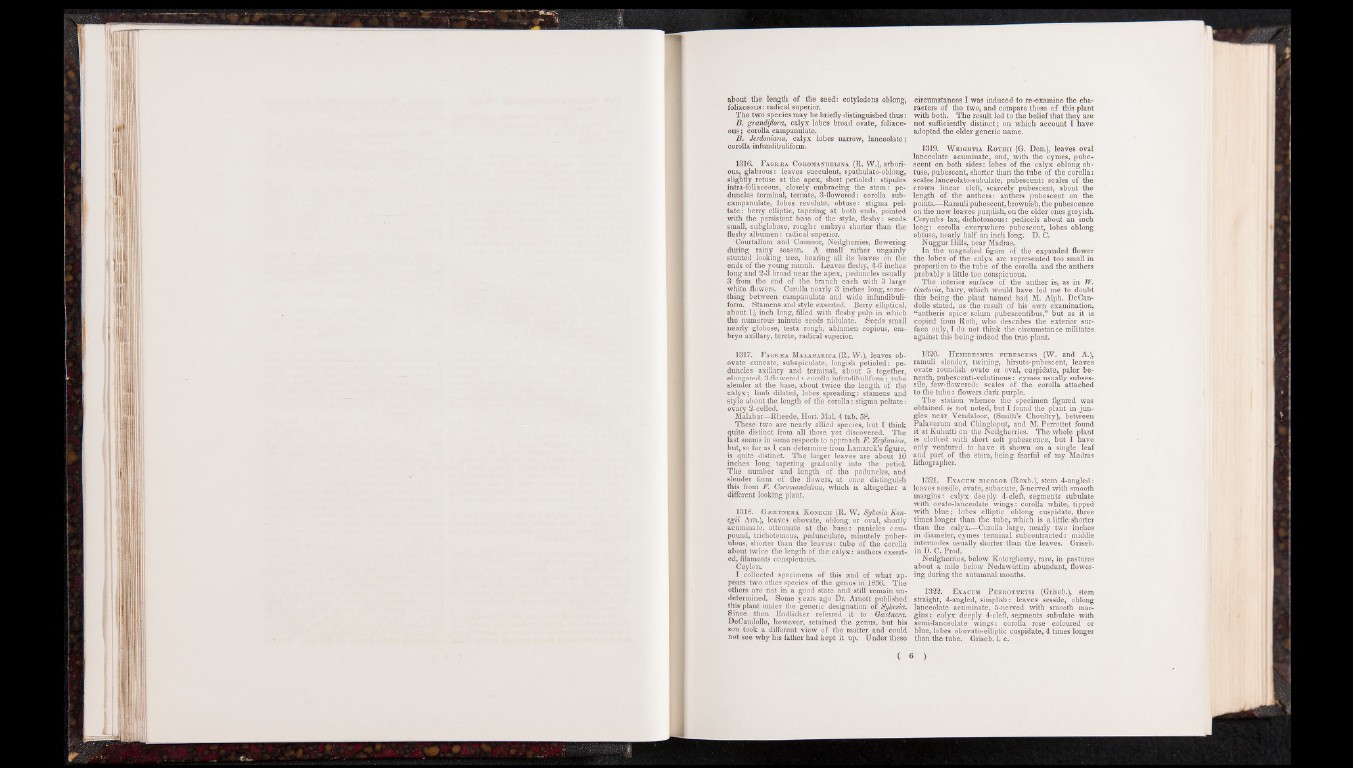
about the length of the seed: cotyledons oblong,
foliaceous: radical superior.
The two species may be briefly distinguished thus:
B . grandijlora, calyx lobes broad ovate, foliaceous
; corolla campanulate.
B. Jerdoniana, calyx lobes narrow, lanceolate;
corolla infundibuliform.
1316. F agiuea Coromandelina (R. W.), arbori-
ous, glabrous: leaves succulent, spathulato-oblong,
slightly retuse at the apex, short petioled: stipules
intra-foliaceous, closely embracing the stem: peduncles
terminal, temate, 3-flowered: corolla sub-
campanulate, lobes revolute, -obtuse: stigma peltate:
berry elliptic, tapering at both ends, pointed
with the persistent base of the style, fleshy: seeds
small, subglobose, rough: embryo shorter than the
fleshy albumen: radical superior.
Courtallum and Coonoor, Neilgherries, flowering
during rainy season. A small rather ungainly
stunted looking tree, bearing all its leaves on the
ends of the young ramuli. Leaves fleshy, 4-6 inches
long and 2-3 broad near the apex, peduncles usually
3 from the end of the branch each with 3 large
white flowers. Corolla nearly 3 inches long, something
between campanulate and wide infundibuliform.
Stamens and style exserted. Berry elliptical,
about lg inch long, filled with fleshy pulp in which
the numerous minute seeds nidulate. Seeds small
nearly globose, testa rough, ablumen copious, embryo
axillary, terete, radical superior.
1317. Fagrasa Malabarica (R. W.), leaves ob-
ovate cuneate, subapiculate, longish petioled: peduncles
axillary and terminal, about 5 together,
elongated, 3-flowered: corolla infundibuliform; tube
slender at the base, about twice the length of the
calyx; limb dilated,-lobes spreading: stamens and
style about the length of the corolla: stigma peltate:
ovary 2-celled.
Malabar—Rheede, Hort. Mai. 4 tab. 58.
These two are nearly allied species, but I think
quite distinct from all those yet discovered. The
last seems in some respects to approach F. Zeylanica,
but, so far as I can determine from Lamarck’s figure,
is quite distinct. The larger leaves are about 10
inches long tapering gradually into the petiol.
The number and length of the peduncles, and
slender form of the flowers, at once distinguish
this from jF. Coromandelina, which is altogether a
different looking plant.
1318.. Gjertnera Konegii (R. W. Sykesia Kon-
egii Am.), leaves obovate, oblong or oval, shortly
acuminate, attenuate at the base: panicles compound,
trichotomous, pedunculate, minutely puber-
ulous, shorter than the leaves: tube of the corolla
about twice the length of the calyx: anthers exserted,
filaments conspicuous.
Ceylon.
I collected specimens of this and of what appears
two other species of the genus in 1836. The
others are not in a good state and still remain undetermined.
Some years ago Dr. Arnott published
this plant under the generic designation of Sykesia.'
Since then Endlicher referred it to Gartnera.
DeCandolle, however, retained the genus, but his
son took a different view of the matter and could
not see why his father had kept it up. Under these
circumstances I was induced to re-examine the characters
of the two, and compare those of this plant
with both. The result led to the belief that they are
not sufficiently distinct; on which account I have
adopted the older generic name.
1319. W rigiitia R othii (G. Don.), leaves oval
lanceolate acuminate, and, with the cymes, pubescent
on both sides: lobes of the calyx oblong obtuse,
pubescent, shorter than the tube of the corolla:
scales lanceolato-subulate, pubescent: scales of the
crown linear cleft, scarcely pubescent, about the
length of the anthers: anthers pubescent on the
points.—Ramuli pubescent, brownish, the pubescence
on the new leaves purplish, on the older ones greyish.
Corymbs lax, dichotomous: pedicels about an inch
long: corolla everywhere pubescent, lobes oblong
obtuse, nearly half an inch long. D. C.
Nuggur Hills, near Madras.
In the magnified figure of the expanded flower
the lobes of the calyx are represented too small in
proportion to the tube of the corolla and the anthers
probably a little too conspicuous.
The interior surface of the anther is, as in W.
tindoria, hairy, which would have led me to doubt
this being the plant named had M. Alph. DeCandolle
stated, as the result of his own examination,
“antheris apice solum pubescentibus,” but as it is
copied from Roth, who describes the exterior surface
only, I do not think the circumstance militates
against this being indeed the true plant
1320. Hemidesmus pubescens (W. and A.),
ramuli slender, twining, hirsuto-pubescent, leaves
ovate roundish ovate or oval, cuspidate, paler beneath,
pubescenti-velutinous: cymes usually subses-
sile, few-flowered: scales of the corolla attached
to the tube: flowers dark purple.
The station whence the specimen figured was
obtained is not noted, but I found the plant in jungles
near Yendaloor, (Smith’s Choultry), between
Palaverum and Chingleput, and M. Perrottet found
it at Kuhutti on the Neilgherries. The whole plant
is clothed with short soft pubescence, but I have
only ventured to have it. shown on a single leaf
and part of the stem, being fearful of my Madras
lithographer.
1321. Exacubi bicolor (Roxb.), stem 4-angled:
leaves sessile, ovate, subacute, 5-nerved with smooth
margins: calyx deeply 4-cleft, segments subulate
with ovato-lanceolate wings: corolla white, tipped
with blue; lobes elliptic oblong cuspidate, three
times longer than the tube, which is a little shorter
than the calyx.—Corolla large, nearly two inches
in diameter, cymes terminal subcontracted: middle
internodes usually shorter than the leaves. Griseb.
in D. C. Prod.
Neilgherries, below Kotergherry, rare, in pastures
about a mile below Nedawuttim abundant, flowering
during the autumnal months.
1322. Exacubi Perrotxetii (Griseb.), stem
straight, 4-angled, simplish: leaves sessile, oblong
lanceolate acuminate, 5-nerved with smooth margins
: calyx deeply 4-cleft, segments subulate with
semi-lanceolate wings: corolla rose coloured or
blue, lobes obovato-elliptic cuspidate, 4 times longer
than the tube. Griseb. 1. c.